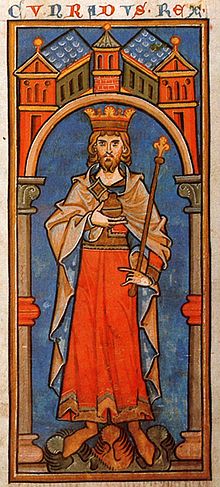| Conrad III | |
|---|---|
 A miniature from the Chronica sancti Pantaleonis, c. 1240 | |
| King of Germany (formally King of the Romans) | |
| Reign | 7 March 1138 – 15 February 1152 |
| Coronation | 13 March 1138, Aachen |
| Predecessor | Lothair III |
| Successor | Frederick I |
| King of Italy | |
| Reign | 1128–1135 |
| Coronation | 29 June 1128, Milan |
| Predecessor | Henry V |
| Successor | Frederick I |
| Born | 1093 or 1094 |
| Died | 15 February 1152
(aged 59–60) Bamberg, Bavaria |
| Burial | |
| Spouse | |
| Issue | |
| House | Hohenstaufen |
| Father | Frederick I, Duke of Swabia |
| Mother | Agnes of Germany |
Conrad III (German: Konrad; Italian: Corrado; 1093 or 1094 – 15 February 1152) of the Hohenstaufen dynasty was from 1116 to 1120 Duke of Franconia, from 1127 to 1135 anti-king of his predecessor Lothair III, and from 1138 until his death in 1152 King of the Romans in the Holy Roman Empire. He was the son of Duke Frederick I of Swabia and Agnes,[1] a daughter of Emperor Henry IV.[2][3]
His reign saw the start of the conflicts between the Guelphs and Ghibellines. He was involved in the failed Second Crusade with Louis VII, where he would fight and lose at Doryleum and would later fall ill and return to Constantinople. After recuperating, he went to Jerusalem but would experience a string of failed sieges. Later returning from the Crusade, he was entangled in some conflicts with Welf VI's claim to the Duchy of Bavaria. On his deathbed, he designated his nephew Frederick Barbarossa as his successor instead of his son, Frederick IV, Duke of Swabia.
- ^ Frederick I 2000, p. xii.
- ^ John Middleton (2015). World Monarchies and Dynasties. Routledge. pp. 403–. ISBN 978-1-317-45158-7.
- ^ Wilhelm Muschka (2012). Agnes von Waiblingen – Stammmutter der Staufer und Babenberger-Herzöge: Eine mittelalterliche Biografie. Tectum Wissenschaftsverlag. pp. 74–. ISBN 978-3-8288-5539-7.